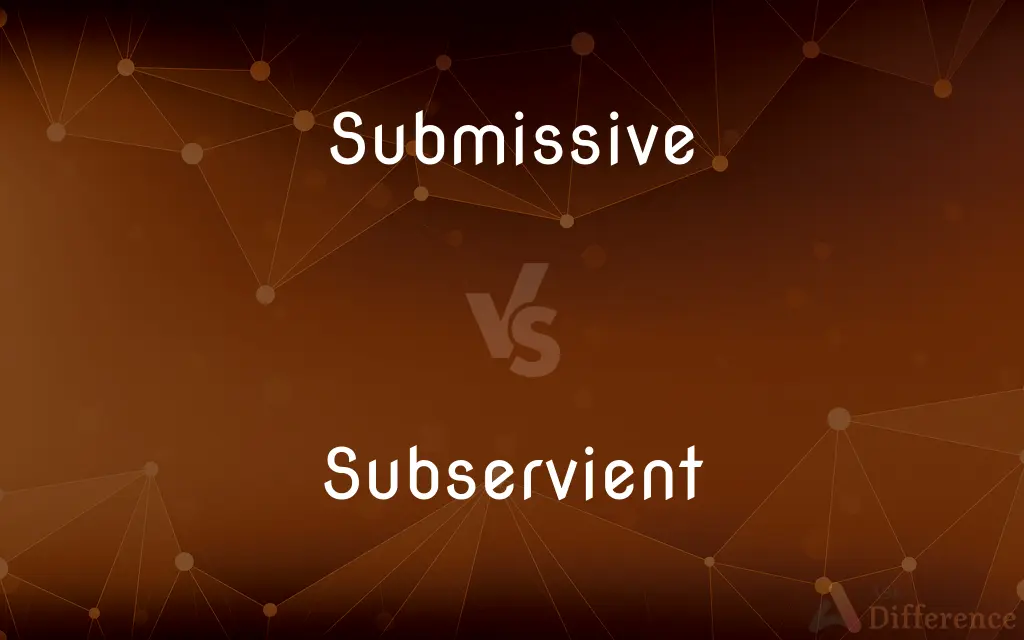Submissive vs. Subservient — What's the Difference?
By Tayyaba Rehman & Fiza Rafique — Updated on March 14, 2024
Submissive implies compliance, while subservient suggests inferiority.

Difference Between Submissive and Subservient
Table of Contents
ADVERTISEMENT
Key Differences
Submissive behavior is characterized by a willingness or readiness to conform to the authority or will of others, often seen in various personal and professional relationships. It involves yielding or surrendering one's own preferences, desires, or decisions to someone else. Whereas, subservient behavior goes a step further, entailing a more extreme form of submission that often implies acting in an excessively obedient manner, to the point of undermining one's own dignity or self-worth.
While a submissive person might accept or follow another's lead, requests, or commands out of respect, trust, or choice, a subservient individual often does so out of a perceived obligation or inferiority, potentially neglecting their own needs or desires in the process. Submissiveness can be a component of a healthy dynamic, where there is mutual respect and understanding, on the other hand, subservience often hints at a more one-sided relationship, where the balance of power is significantly skewed.
Submissive behavior can be temporary and situational, depending on the context and the individuals involved. Subservient behavior, however, tends to be more ingrained and habitual, reflecting a deeper, often ingrained sense of inferiority or compulsion to please others at one's own expense.
The concept of being submissive can be voluntary and arise from personal choice or preference, including in consensual power-exchange relationships. Subservience, however, is rarely a matter of personal choice and more often results from external pressures, coercion, or a deeply embedded belief in one's own lesser value or status.
Submissiveness and subservience both involve yielding to others, but the key difference lies in the degree and the underlying motivation. Submissiveness is about compliance and can be a positive trait in certain contexts, while subservience is marked by an over-willingness to serve others to the detriment of one's own position or self-esteem.
ADVERTISEMENT
Comparison Chart
Definition
Willingness to comply with the will of others
Excessive readiness to act in an obedient, often inferior, manner
Implication
Compliance and yielding
Inferiority and undermining self-worth
Power Dynamics
Can be part of a healthy, consensual dynamic
Implies a skewed power balance, often not consensual
Motivation
Can be a choice or preference
Often stems from perceived obligation or inferiority
Context
Situational and voluntary
Habitual and ingrained
Compare with Definitions
Submissive
Ready to conform to the authority or will of others.
In the meeting, she was submissive and agreed with all the suggestions made by her colleagues.
Subservient
Excessively willing to obey others.
The employee's subservient attitude made him take on tasks beyond his responsibilities, often at his own expense.
Submissive
Yielding one's preferences or decisions.
He adopted a submissive posture during negotiations, opting to agree rather than confront.
Subservient
Undermining one's dignity to serve.
He felt subservient in the new role, as it required him to compromise his principles.
Submissive
Compliance out of respect or trust.
She was submissive to her mentor's guidance, trusting his experience.
Subservient
Habitual obedience, hinting at coercion.
The subservient stance she took in every discussion suggested a lack of confidence in her own ideas.
Submissive
Characterized by a willingness to follow.
The submissive dog obeyed every command its owner gave.
Subservient
Acting in an inferior manner to please others.
Her subservient behavior at home stemmed from a desire to avoid conflict at all costs.
Submissive
Voluntary yielding in certain contexts.
In their relationship, he chose to be submissive, finding strength in vulnerability.
Subservient
Reflecting an ingrained sense of inferiority.
Growing up in a strict household, he developed a subservient nature that affected his adult relationships.
Submissive
Inclined or willing to submit.
Subservient
Subordinate in capacity or function.
Submissive
Obedient or passive.
Subservient
Obsequious; servile.
Submissive
(BDSM) One who submits to a dominant partner in BDSM practices.
Subservient
Useful as a means or an instrument; serving to promote an end.
Submissive
(rare) One who submits.
Subservient
Useful in an inferior capacity.
Submissive
Inclined or ready to submit; acknowledging one's inferiority; yielding; obedient; humble.
Not at his feet submissive in distress,Creature so fair his reconcilement seeking.
Subservient
Obsequiously submissive.
Submissive
Showing a readiness to submit; expressing submission; as, a submissive demeanor.
With a submissive step I hasted down.
Subservient
Fitted or disposed to subserve; useful in an inferior capacity; serving to promote some end; subordinate; hence, servile, truckling.
Scarce ever reading anything which he did not make subservient in one kind or other.
These ranks of creatures are subservient one to another.
Their temporal ambition was wholly subservient to their proselytizing spirit.
Submissive
Inclined or willing to submit to orders or wishes of others or showing such inclination;
Submissive servants
A submissive reply
Replacing troublemakers with more submissive people
Subservient
Compliant and obedient to authority;
Editors and journalists who express opinions in print that are opposed to the interests of the rich are dismissed and replaced by subservient ones
Submissive
Willing to submit without resistance to authority; deferent
Subservient
Abjectly submissive; characteristic of a slave or servant;
Slavish devotion to her job ruled her life
A slavish yes-man to the party bosses
She has become submissive and subservient
Submissive
Abjectly submissive; characteristic of a slave or servant;
Slavish devotion to her job ruled her life
A slavish yes-man to the party bosses
She has become submissive and subservient
Common Curiosities
Can submissiveness be empowering in certain contexts?
Yes, in consensual relationships or situations where individuals voluntarily choose to be submissive, it can be an empowering and fulfilling experience.
Can subservience be a result of cultural or societal norms?
Yes, in some cultures or societies, subservient behavior might be encouraged or expected in certain roles or relationships, influencing individuals' behavior.
How do power dynamics differ between submissiveness and subservience?
Submissiveness can exist within healthy, balanced power dynamics, while subservience often indicates a skewed power balance, potentially lacking in mutual respect or consent.
What does it mean to be submissive?
Being submissive means willingly complying with or yielding to the authority, will, or preferences of others, often out of respect or trust.
Can a person be submissive without being subservient?
Yes, one can be submissive in certain situations or relationships by choice, without necessarily being subservient or feeling inferior.
Is subservience always involuntary?
While it often stems from external pressures or ingrained beliefs, there might be situations where individuals choose subservient roles for personal reasons, though this is less common.
How can one tell if they are being subservient?
Reflecting on whether obedience or service comes from a place of fear, obligation, or a sense of inferiority can help distinguish subservient behavior.
What does subservient mean?
Subservient implies an excessive readiness to obey others, often to the point of acting in an inferior manner or undermining one's own self-worth.
Is being subservient a negative trait?
While it can be seen as negative, especially if it leads to a loss of dignity or self-esteem, the context and reasons behind subservient behavior can vary widely.
How can one address subservient behavior?
Recognizing the underlying reasons, seeking support, establishing boundaries, and developing self-esteem can help address subservient behavior.
Can therapy help with subservient tendencies?
Yes, therapy can be an effective way to explore the roots of subservient behavior, develop healthier coping mechanisms, and build self-worth.
How do societal views on submissiveness and subservience differ?
Societal views can vary widely, but generally, submissiveness may be more accepted or valued in certain contexts than subservience, which is often viewed negatively.
What are the implications of subservient behavior in the workplace?
Subservient behavior in the workplace can lead to exploitation, lack of recognition, and can undermine professional growth and self-esteem.
Can submissiveness change over time?
Yes, individuals' willingness to be submissive can change based on personal growth, experiences, and changes in the dynamics of relationships or situations.
Does subservience affect personal relationships?
Yes, subservient behavior can significantly impact personal relationships, often leading to imbalances of power and potential resentment.
Share Your Discovery

Previous Comparison
Base vs. Evil
Next Comparison
Munition vs. AmmunitionAuthor Spotlight
Written by
Tayyaba RehmanTayyaba Rehman is a distinguished writer, currently serving as a primary contributor to askdifference.com. As a researcher in semantics and etymology, Tayyaba's passion for the complexity of languages and their distinctions has found a perfect home on the platform. Tayyaba delves into the intricacies of language, distinguishing between commonly confused words and phrases, thereby providing clarity for readers worldwide.
Co-written by
Fiza RafiqueFiza Rafique is a skilled content writer at AskDifference.com, where she meticulously refines and enhances written pieces. Drawing from her vast editorial expertise, Fiza ensures clarity, accuracy, and precision in every article. Passionate about language, she continually seeks to elevate the quality of content for readers worldwide.













































